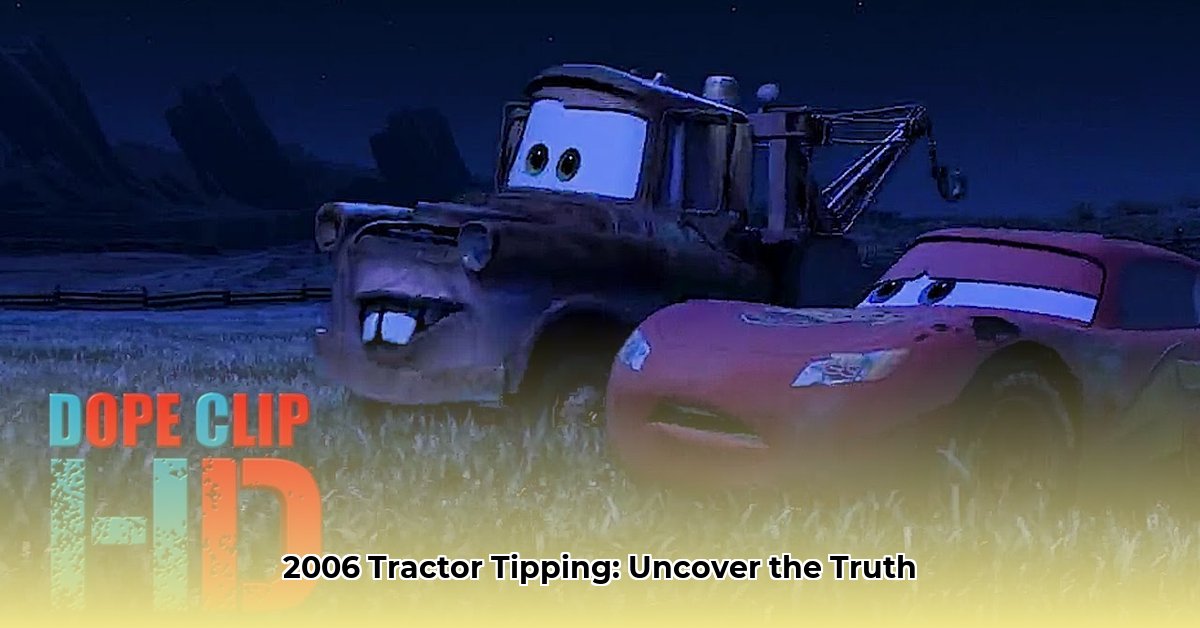
The 2006 Pixar film Cars is more than just a visually stunning animated feature; it's a nuanced narrative exploring themes of friendship, self-discovery, and the importance of community. For a fun interactive experience related to this pivotal scene, check out this tractor tipping game. While seemingly minor, the tractor-tipping scene serves as a microcosm of the film's larger message, powerfully impacting character development, showcasing Pixar's animation prowess, and contributing significantly to the film's overall emotional resonance. This analysis will explore the scene's narrative function, technical achievements, and lasting impact.
The Narrative Significance of the Tip
The tractor-tipping scene isn't mere slapstick; it's a pivotal moment in the burgeoning friendship between Lightning McQueen, the ambitious race car, and Mater, his seemingly bumbling tow-truck companion. Before the incident, McQueen views Mater primarily as comic relief. The chaotic tipping of the tractor, however, reveals Mater's unexpected resourcefulness and quick thinking. He instinctively acts to solve the problem, displaying a level of competence and bravery previously unseen. This unexpected display of ingenuity shifts McQueen's perception of Mater, moving their relationship from a somewhat patronizing dynamic to one of genuine respect and camaraderie. Furthermore, the scene foreshadows the larger challenges they will face together, underscoring the film's central theme of the importance of teamwork and believing in each other, even amidst chaos. The seemingly simple scene subtly enhances the narrative by deepening the relationship between the protagonists just as their journey is progressing.
Pixar's Technical Mastery: Animating a Moment of Truth
The tractor-tipping scene showcases Pixar's animation mastery. The realism of the tractor's physics – its weight, its movement as it tips, the resulting dust cloud – is remarkable, especially considering the technology available in 2006. The lighting, the way the sun bathes the scene, enhances the sense of a tangible, believable world. These technical choices aren't merely impressive; they serve the narrative. The heightened realism enhances the humor, making the characters' reactions all the more entertaining and genuine. Careful camera angles emphasize both the chaotic nature of the event and the characters' expressions, maximizing the comedic and emotional impact. By meticulously crafting the scene's animation, Pixar ensures that it's not merely visually appealing but also narratively effective, skillfully blending realism and carefully controlled cartoon exaggeration. The careful balance between these elements is a hallmark of Pixar's signature style, and this scene is an excellent example.
Character Development: Beyond the Laughs
The tractor-tipping scene significantly contributes to the characters' development. For Mater, it marks a shift from comedic sidekick to resourceful problem-solver; it's a crucial moment in his narrative arc. His quick thinking and unexpected competence reshape the audience's understanding of him, moving beyond the initial perception of him as purely comic relief. For McQueen, the scene serves as a lesson in humility. His initial dismissal of Mater's capabilities is challenged by the events, leading him to appreciate Mater's value as a friend and a valuable member of their team. This pivotal moment helps develop McQueen's character from an arrogant, self-centered racer to a more thoughtful and appreciative individual. The humorous situation underpins and enhances a genuine and touching moment of character growth.
The Scene's Lasting Impact: A Memorable Moment
While precisely quantifying the scene's overall cultural impact is difficult, its enduring popularity among Cars fans and its memorable nature within the broader context of Pixar's filmography suggest a substantial effect. The scene's blend of humor, technical brilliance, and effective character development has likely influenced subsequent animated productions, showcasing the power of seemingly simple moments to achieve profound narrative impact. Its effectiveness lies in the masterful combination of animation and storytelling—a characteristic that has become a hallmark of Pixar's filmmaking.
Limitations and Future Research
This analysis is limited by the lack of access to production details and behind-the-scenes information. Further research, including interviews with the filmmakers and animators, could offer valuable insight into the creative decisions that shaped the scene. A comparative study examining similar scenes in other animated films could also shed light on its uniqueness and influence. Qualitative analysis of audience reception, through surveys or social media analysis, could explore the scene's lasting impact on viewers. By exploring these avenues, we can achieve a more complete understanding of the scene's significance within the broader context of animation and storytelling.